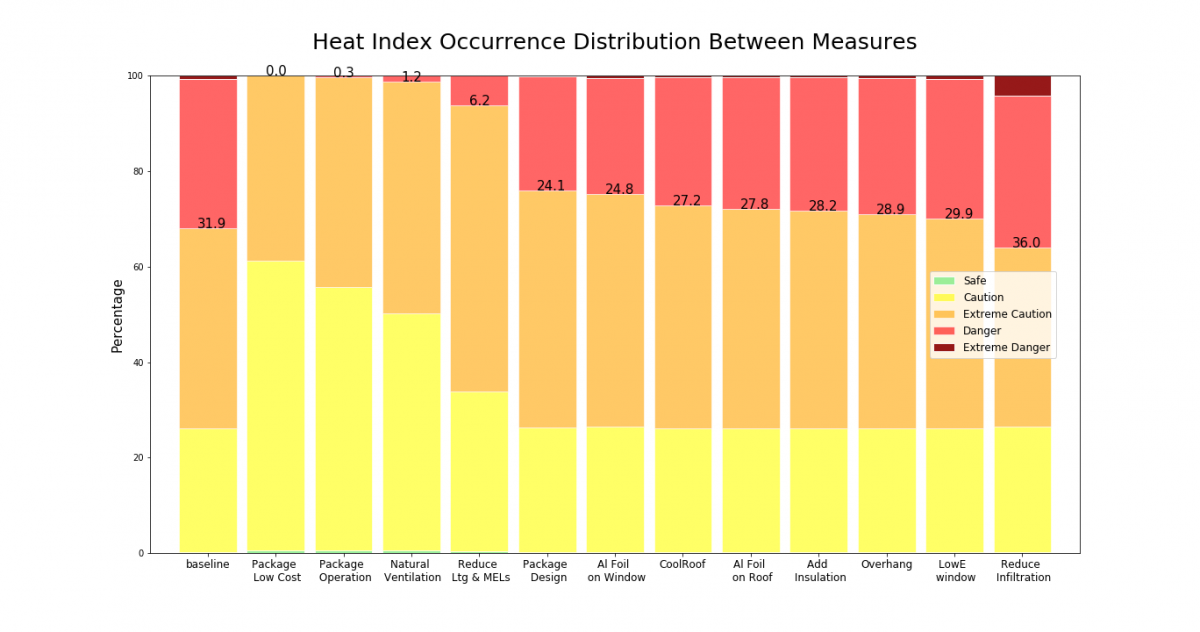Prediction and Modeling
Prediction and Modeling
Heat Resilience and Building Energy Efficiency
ETA researchers are studying the nexus of heat resilience and energy-efficiency of buildings.
 We conducted a modeling case study of a nursing home in Florida where 12 patients died during the 2017 Hurricane Irma due to the power loss of the HVAC systems. The objective was to understand and quantify how passive and active energy efficiency measures (EEMs) can improve heat resilience to reduce heat-exposure risk of patients. The analysis included assessment of EEM cost, as well as scenarios for the same facility, were it located in two other typical climates, San Francisco (moderate) and Chicago (hot-humid summer cold winter).
We conducted a modeling case study of a nursing home in Florida where 12 patients died during the 2017 Hurricane Irma due to the power loss of the HVAC systems. The objective was to understand and quantify how passive and active energy efficiency measures (EEMs) can improve heat resilience to reduce heat-exposure risk of patients. The analysis included assessment of EEM cost, as well as scenarios for the same facility, were it located in two other typical climates, San Francisco (moderate) and Chicago (hot-humid summer cold winter).
Main findings from this study include:
- Passive measures that may not save significant amounts of energy may greatly improve heat resilience and thus should be considered in the building design or retrofit.
- Passive measures can reduce the risk of dangerous conditions but could not guarantee safe conditions for occupants. Active measures, such as cool energy storage or PV that powers a half capacity of cooling systems, are needed to provide cooling to maintain safe conditions for occupants.
- EEMs’ impacts on heat resilience vary significantly with the climate and baseline building characteristics.
- The most effective efficiency measures (e.g., opening windows) were also the least expensive to implement. This encouraging result indicates that low- to no-cost measures could potentially be deployed in buildings in near-real time to enhance passive survivability by allowing residents to shelter-in-place.
Weather Effects on the Lifecycle of Department of Defense Equipment Replacement (WELDER)
 Given increasing threats of extreme weather events, facility planners and policymakers need state-of-the-art information that projects long-term environmental risk and informs how these events may alter the replacement schedules and the performance profiles of individual facilities and their constituent systems and components. The BUILDER Sustainment Management System—the lifecycle management tool used by the U.S. Department of Defense (DoD) to consistently and comprehensively assess and forecast facility conditions—does not currently consider vulnerability to extreme weather events. This project will develop an application programming interface (API) plug-in for BUILDER that allows users to visualize weather event projections and re-prioritize infrastructure maintenance and/or replacement schedules, and assess costs, according to the likelihood and severity of these events with and without adaptive response scenarios.
Given increasing threats of extreme weather events, facility planners and policymakers need state-of-the-art information that projects long-term environmental risk and informs how these events may alter the replacement schedules and the performance profiles of individual facilities and their constituent systems and components. The BUILDER Sustainment Management System—the lifecycle management tool used by the U.S. Department of Defense (DoD) to consistently and comprehensively assess and forecast facility conditions—does not currently consider vulnerability to extreme weather events. This project will develop an application programming interface (API) plug-in for BUILDER that allows users to visualize weather event projections and re-prioritize infrastructure maintenance and/or replacement schedules, and assess costs, according to the likelihood and severity of these events with and without adaptive response scenarios.
Find out more at: www.serdp-estcp.org/Program-Areas/Resource-Conservation-and-Resiliency/Infrastructure-Resiliency/Vulnerability-and-Impact-Assessment/RC19-5264
